Free Macro Meal Plan Template [Google Sheets]
Are you looking to start following a macro meal plan but don’t know how to get started?
Are you feeling overwhelmed by all of the different meal planning apps out there and want to just use something simple?
If you have answered yes to either of these questions, then this free macro meal plan template is for you!
A macro meal plan template is a great way to start following a diet plan, as it takes all of the guesswork out of calculating your macros. It also provides you with a structure to follow, which can be helpful when you’re first starting.
In this article, I will explain why it’s beneficial to follow such a meal plan, show you how to create and use one, and give you some tips on staying on track.
GET THE TEMPLATE
Macro meal plan template – just click on the link to make your own editable copy in Google Sheets.
Jump to sections:
- What is Macro Meal Planning?
- Benefits of Following a Macro Meal Plan
- How To Get Macro Meal Plan Template?
- How Do I Create a Meal Plan for My Macros?
- How To Use Macro Meal Planner Template?
- Examples of Macro Meal Plans
- 5 Tips When Following a Meal Plan
- Frequently Asked Questions About Macro Meal Planning
What is Macro Meal Planning?
Macro meal planning is a way of eating that focuses on consuming the right proportions of macronutrients (fat, protein, and carbohydrates) in each meal.
Each gram of macronutrient has a different calorie value:
- 1 gram of fats contains 9 calories per gram
- 1 gram of protein contains 4 calories per gram
- 1 gram of carbohydrates contains 4 calories per gram
When you know the calorie value of each macronutrient, you can then calculate how many grams of each you should be eating in order to reach your desired daily calorie intake.
Following such a plan allows you to control your calorie intake and ensures that you are getting the right proportions of macronutrients, as each one has different benefits for the body.
This approach to nutrition can be helpful for people who are looking to lose weight, gain muscle, or improve their overall health.
Benefits of Following a Macro Meal Plan
Proper macronutrient ratios are a core part of a healthy and effective diet.
When you follow a macro meal plan, you are in control of your calorie intake and can make sure that you are getting the right amounts of each macronutrient.
This can lead to a number of benefits, including:
- Fat loss: By controlling your calorie intake and ensuring that you are getting the right macro ratios, you can lose weight in a healthy way, while minimizing potential muscle loss.
- Muscle gain: Eating the right amounts of protein, and carbohydrates, and consuming enough calories can help you build muscle.
- Improved health: Eating a balanced diet that includes all of the essential nutrients in the right proportions can improve your overall health.
- Balanced and sustainable energy levels: When you consume the right amounts of each macronutrient, your body has the fuel it needs to maintain balanced and sustainable energy levels throughout the day.
- Control over food cravings: When you are getting the right amounts of each macro, especially protein and fats, you can avoid food cravings and maintain better control over your eating.
- Digestion and nutrient absorption: Your digestive system can function properly and you can absorb more nutrients from the food you eat.
How To Get Macro Meal Plan Template?
GET THE TEMPLATE
Free macro meal builder template – just click on the link to make your own editable copy in Google Sheets.
Once you click on the link and click the “Make a copy” button, a new Google Sheet will open up in your browser where you can start creating your meals.

How Do I Create a Meal Plan for My Macros?
Creating a macro meal plan that is tailored to your specific goals and needs is pretty simple.
Here’s a brief step-by-step guide on how to do it:
- First, you need to calculate your daily calories and macro requirements. You can use this macro calculator. Or you can learn how to calculate your macros manually depending on your fitness goal – cutting or lean bulking.
- Once you know your daily macro requirements, you can start creating your meal plan using the template. More on this in a bit.
- Start by creating a list of all the meals and snacks you want to eat in a day.
- Then, fill in the details for each meal, including the food items, and portion sizes.
How To Use Macro Meal Planner Template?
Now that you know how to create a meal plan, it’s time to put your knowledge into practice.
The Basics
There are the following sheet tabs in the template:
- Meal Plan: This is where you will enter your meals and snacks for the day.
- Protein (Data), Carbs (Data), Veggies (Data), Fruits (Data), Fats (Data), Condiments (Data): All these sheets contain the nutritional information of each food item, and some formulas.
NOTE
Throughout the whole spreadsheet, I have coloured cells in light yellow and light blue.
Here’s what it means:
- Light yellow cells are the ones you will be able to edit.
- Light blue cells are the ones that contain formulas. Be careful, do not delete or edit them!
Now, let me quickly explain the logic behind creating meals:
- When creating a meal, first, next to the food group you need to select the food category from the drop-down.
- After that, you will be able to select appropriate food items from the next drop-down on the right.
- Then you will need to enter the portion size in grams.
- As soon as you enter the portion size all the nutritional information for that particular food will be populated in the cells on the right side.
I also recommend you use this method when structuring meals:
- For each meal, think of which food item you would like to eat from each of the macronutrients. If you are not familiar with which foods contain which macros, here’s a simple food macro cheat sheet.
- Then form meals around those food items.
For example, when coming up with dinner, I might want salmon as the source of protein and healthy fats, and rice as a carbohydrate source, when it comes to veggies, I could choose asparagus.
You can use this method for each meal of the day.
How to Create Meals
Now, when all this is out of the way, let’s move on and see how to actually create meals using this template.
Once you open up the template, you will see an empty meal plan.
First, right next to each cell under the “Food Group” column, you will need to select the “Food Category” from the drop-down.

After that, on the cell to the right, under the “Food Item” column, click on the drop-down to select an appropriate food item.
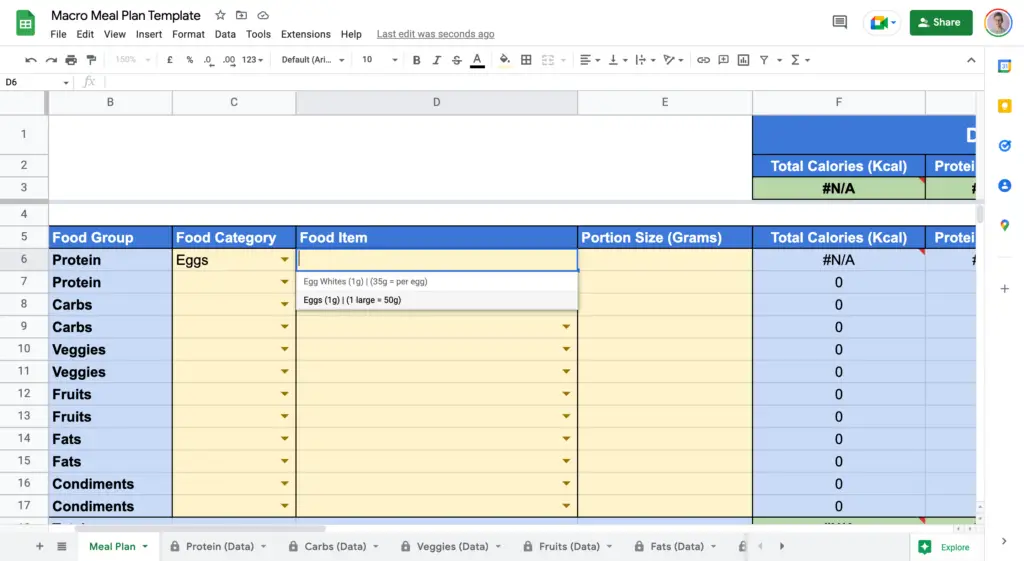
Lastly, you will need to enter the quantity/portion size for that particular food item in grams.
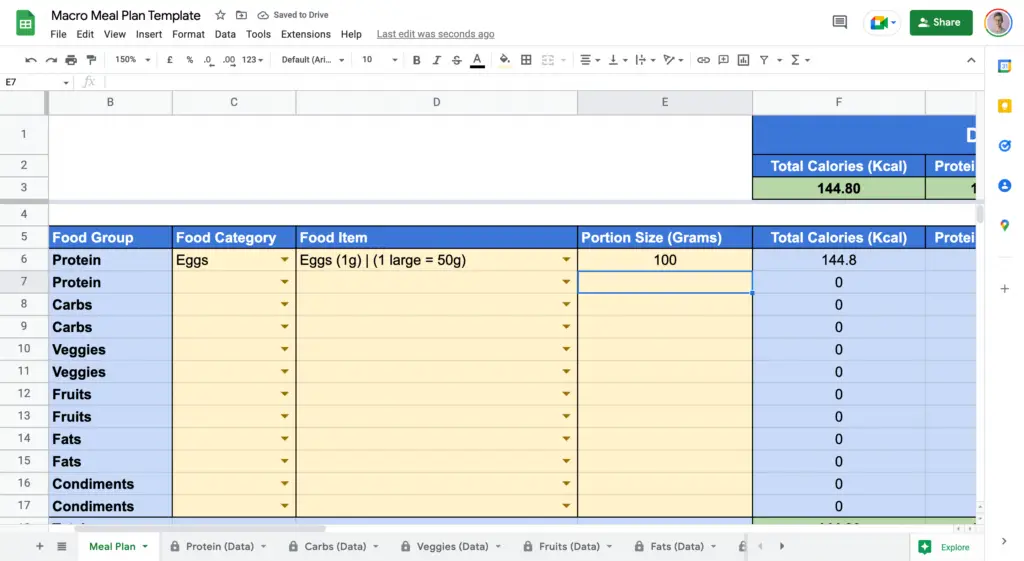
The template is set up in a way that it will automatically populate all the nutritional information, including total calories, macros – protein, fats and carbs, for the food item, the total meal, and all meals for the day combined.
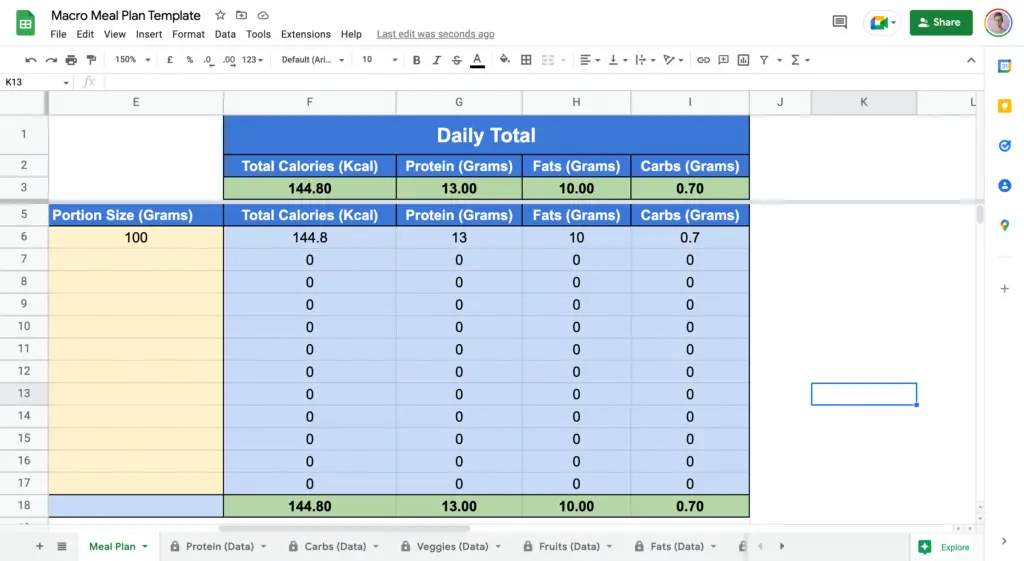
You will have to repeat the process for each food item you want to add to the meal.
When you are done, the meal should look something like this.
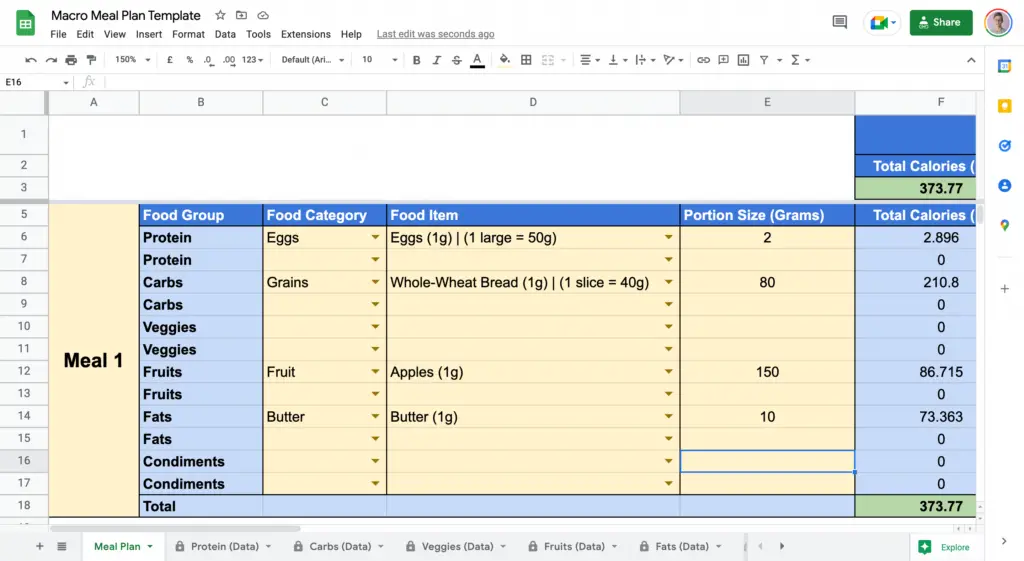
As you can see it also populates all the nutritional information for that particular meal.
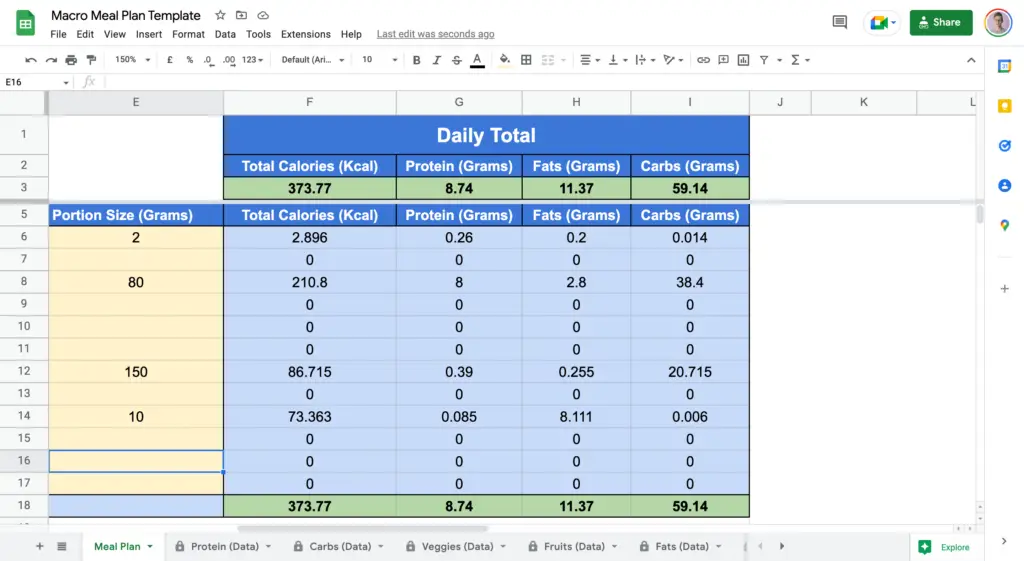
You can then repeat the process for each meal of the day.
How to Add More Food Items
In some rare cases, you might see that the food item you are looking for is not on the list.
NOTE
Over time I will be updating and adding more food items to the list. In the meantime, if you want to add more food items to the list, read on.
To add more food items to the template, first, go to the appropriate sheet that contains (Data) in its name.
Then find the relevant “Food Category” where you want to add your food item.
Let’s say that in my example, I want to add a “Canned Tuna in Water”, so I will have to go to the “Protein (Data)” sheet and find “Fish” under the “Food Category” column.
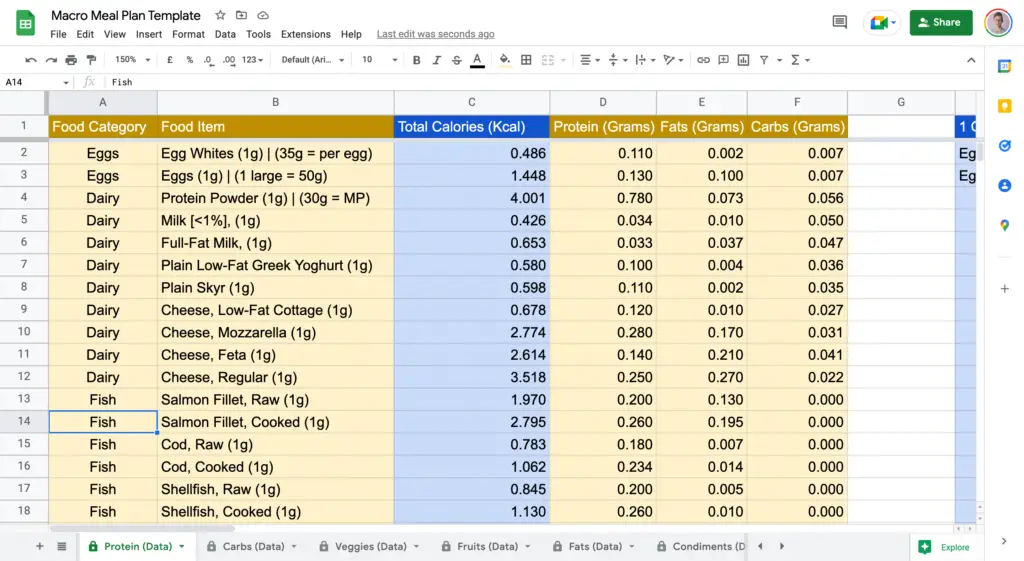
Then, you will need to insert a new row somewhere in between all the other foods in that food category.

NOTE
This is very important that you insert the new row in between all the other foods in the relevant category – as it will ensure that the drop-down list for food items works properly.
You will also notice that a “Head’s up!” warning notice will appear, telling you that this sheet is protected. This is because the sheet is protected to avoid accidentally deleting formulas.
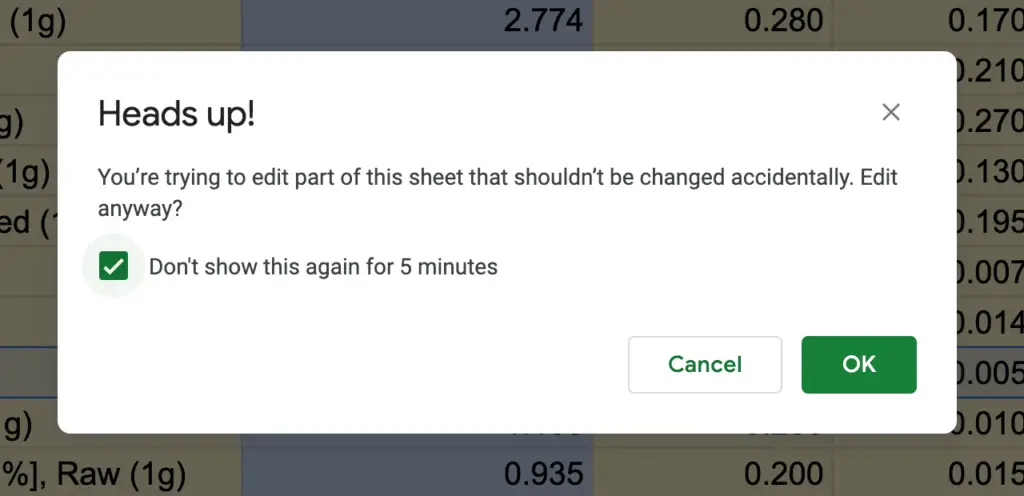
You can tick “Don’t show this again for 5 minutes” and click OK since you will need to make a few more changes.
Then you will need to type in the following information in the new row, under the appropriate columns:
- Write the category name of the food under the “Food Category” column
- Write the name of the food item under the “Food Item” column
- Then, under the appropriate columns, fill in the number of grams of protein, fats and carbs the food item contains per 100 grams, and divide the number by 100.
For example, 100 grams of canned tuna in cater contains 25.51 grams of protein, so I will input “=25.51/100” in the relevant cell under the “Protein (Grams)” column.
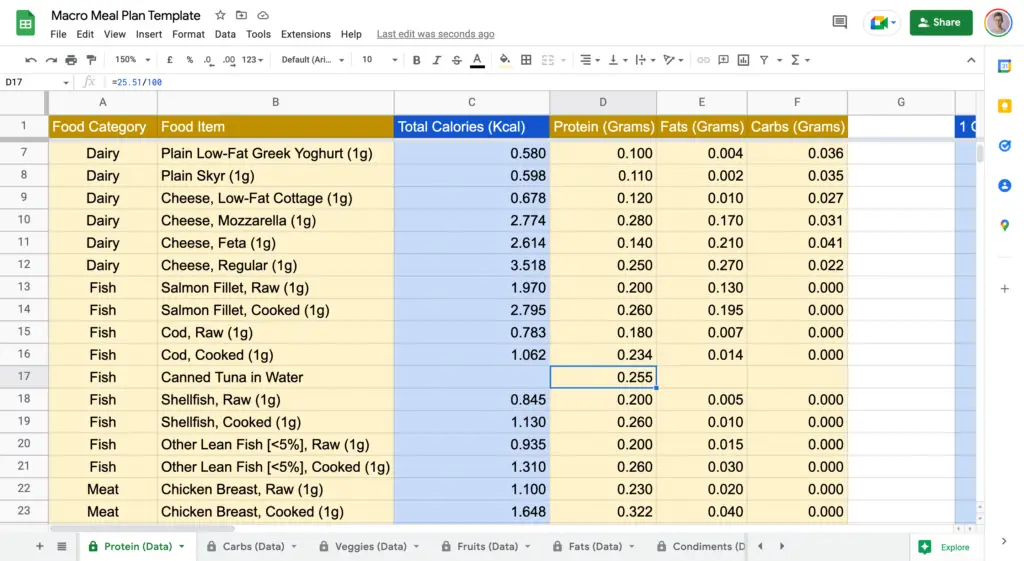
Then, repeat the process for fats and carbs.
You can find the nutritional values of different foods on the internet or on the package label.
Lastly, you will have to copy the formula, under the “Total Calories (Kcal)” column. You can use any cell – above or below to copy the formula.
To do this, you can either, copy/paste the formula with Ctrl + C and Ctrl + V, or you can click on the cell with the formula, hover your mouse over the lower right corner of that cell until you see a little black cross, and then click and drag the formula over to the new row.
Once, you are done, copying the formula, you can ensure it is correct by clicking on the cell and checking whether it used the values in the same new row for the calculation.
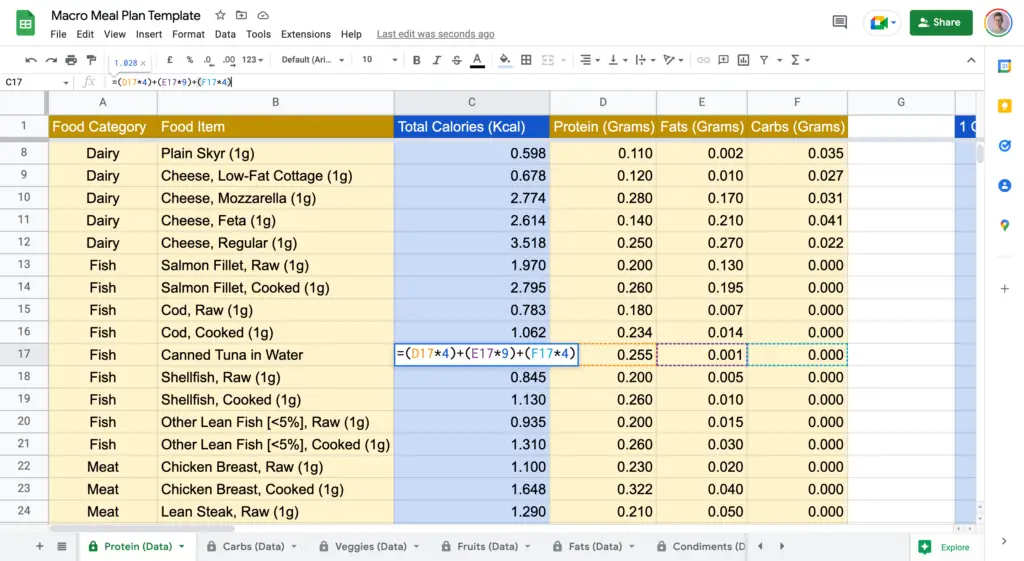
Congrats, you have successfully added a new food item!
Now, you will be able to see the new food item you have added next time you want to add it to your meal plan.
Examples of Macro Meal Plans
I have created 3 macro meal plan examples using this template, with different meals, for different caloric requirements, which you can access here:
You can use these examples of meal plans as an inspiration or as a starting point to create your own personalized meal plan.
5 Tips When Following a Meal Plan
Creating a meal plan is only one part of the puzzle.
In order to make sure you are successful in following your meal plan, there are a few things you should keep in mind:
- Log your meals in advance and meal prep (if needed): This will help you stay on track and make it easier to stick to your meal plan.
- Prioritize reaching your protein intake target: Protein is the most important macronutrient when it comes to building muscle and losing fat. Make sure you reach your protein target for each meal, and then fill up the rest of your macros with carbs and/or fats.
- Include a small treat: Include a small treat (within your macros) every day to stay sane and avoid feeling deprived. This could be a small square of dark chocolate or a scoop of ice-cream.
- Don’t obsess over hitting your macros to the gram: As long as you are close to hitting your macro targets for the day, you will be fine. Don’t stress too much if you go over or under your macros by a few grams here and there.
- Track your progress: Keep track of your progress by taking progress pictures, measuring your body fat percentage, or weighing yourself. This will help you stay motivated and on track.
Frequently Asked Questions About Macro Meal Planning
How Do I Figure Out What Macros I Need?
To macronutrient requirements, you will need to first, calculate your daily calorie needs. Then, you will need to figure out your macronutrient split, for example, 40% protein, 30% carbs, and 30% fat. Lastly, you will need to calculate how many grams of each macronutrient you need to eat per day based on your calorie needs and macronutrient split.
You can also use a macro calculator to do all the heavy lifting for you. Feel free to use my macro calculator to calculate your daily calorie and macronutrient needs.
What Are the Best Foods To Eat When Counting Macros?
There is no such thing as “best” foods when it comes to counting macros. It is all about finding the foods that you like and that fit into your macros.
However, for health reasons, I recommend that you eat mostly whole, unprocessed foods. It’s also fine to include some processed foods as long as they take up a small part of your overall diet. For example, I prefer to have 80% of my diet be whole, unprocessed foods, and the other 20% can be whatever I want.
How Do You Hit a Protein Intake Goal?
If you want to hit your protein intake goal, I recommend that you include a source of protein at every meal. Or consume protein-rich food as a snack.
Some good sources of protein include lean meat, fish, eggs, dairy (Icelandic yoghurt, greek yoghurt, cottage cheese), tofu, tempeh, beans and legumes. Protein supplements such as whey protein powder or protein bars can also be a convenient way to hit your protein intake goal.
How Do You Hit a Carb Intake Goal?
If you want to hit your carb intake goal, It’s best if you plan out your meal plan in advance and include a source of carbs in every meal.
Some good sources of carbs include starchy vegetables (potatoes and sweet potatoes), fruits, oats, rice, quinoa, and bread.
You can also consume some quick snacks such as fruit, granola bar or a baked product to help you reach your carb intake goal.
How Do You Hit a Fat Intake Goal?
Hitting your fats intake should not be a problem unless you are following a very low-fat diet.
Some good sources of fat include avocados, nuts and seeds, nut butter, olive oil, and coconut oil. You can use these healthy fats in cooking or add them to your meals.
You can also consume some high-fat snacks such as dark chocolate, trail mix, and full-fat yoghurt to help you reach your fat intake goal.
Final Thoughts
Macro meal planning is a great way to help you stay on track with your nutrition goals. It can be beneficial for weight loss, muscle gain, and improving overall health.
If you’re looking for a macro meal creator template, I have one available for you.
Just follow the steps outlined in this article to get started!
Additionally, if you are interested in tracking your workouts in the gym, I suggest checking out my free Google Sheets workout log template.
If you have any questions, don’t hesitate to reach out to us. I am always happy to help!
Have you ever tried following a macro meal plan?
What was your experience like, do you have any suggestions on how to make it better?
Let me know in the comments below!
![Grocery List Template – Google Sheets [FREE]](https://gfitnessonline.com/wp-content/uploads/2022/06/shopping-list.jpg)

![Mini Cut: What It Is and How To Do It Right [Ultimate Guide]](https://gfitnessonline.com/wp-content/uploads/2022/04/man-with-prepared-meals-768x385.jpg)



